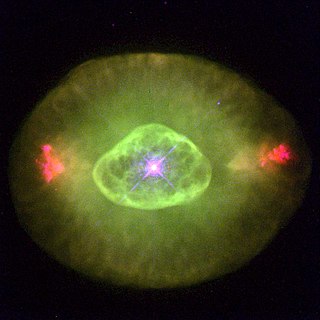
NGC 6826 is a planetary nebula located in the constellation Cygnus. It is commonly referred to as the "Blinking Planetary", although many other nebulae exhibit such "blinking". When viewed through a small telescope, the brightness of the central star overwhelms the eye when viewed directly, obscuring the surrounding nebula. However, it can be viewed well using averted vision, which causes it to "blink" in and out of view as the observer's eye wanders.

NGC 1555, sometimes known as Hind's Variable Nebula, Sh2-238 or HH 155, is a variable nebula 4 light years across, illuminated by the star T Tauri, located in the constellation Taurus. It is 400 light years away from Earth, and has a magnitude (B) of 9.98. It is also in the second Sharpless catalog as 238. It is a Herbig–Haro object. The nebula was discovered on October 11, 1852, by John Russell Hind.

NGC 1058 is a Seyfert Type 2 galaxy in the NGC 1023 Group, located in the Perseus constellation. It is approximately 27.4 million light years from Earth and has an apparent magnitude of 11.82. It is receding from Earth at 518 kilometers per second (322 mi/s), and at 629 kilometers per second (391 mi/s) relative to the Milky Way.

The Iris Nebula is a bright reflection nebula in the constellation Cepheus. The designation NGC 7023 refers to the open cluster within the larger reflection nebula designated LBN 487.
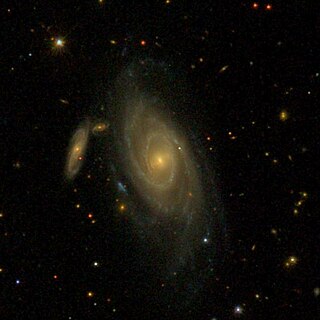
NGC 36 is a barred spiral galaxy in the constellation Pisces. It is located about 221 million light-years away. It was discovered in October 25, 1785, by the astronomer William Herschel.
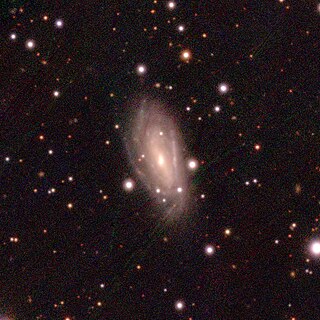
The New General Catalogue object NGC 48 is a barred spiral galaxy located approximately 79.3 million light-years from the Solar System in the constellation Andromeda.

NGC 5177 is a lenticular galaxy. Based on a redshift of 6467 km/s the galaxy is crudely estimated to be about 300 million light-years away.

NGC 7012 is a large, bright elliptical galaxy located about 380 million light-years away from Earth in the constellation Microscopium. NGC 7012 was discovered by astronomer John Herschel on July 1, 1834. NGC 7012 is also is host to a supermassive black hole with an estimated mass of 4.5 × 109M☉. NGC 7012 is very large galaxy, with an estimated diameter of nearly 300,000 light years.

NGC 499, also occasionally referred to as PGC 5060, IC 1686 or GC 289, is a lenticular galaxy in the constellation Pisces. It is located approximately 197 million light-years from the Solar System and was discovered on 12 September, 1784 by astronomer William Herschel.

NGC 522, also occasionally referred to as PGC 5218 or UGC 970, is a spiral galaxy located approximately 122 million light-years from the Solar System in the constellation Pisces. It was discovered on 25 September 1862 by astronomer Heinrich Louis d'Arrest.

NGC 525, also occasionally referred to as PGC 5232 or UGC 972, is a lenticular galaxy located approximately 95.6 million light-years from the Solar System in the constellation Pisces. It was discovered on 25 September 1862 by astronomer Heinrich d'Arrest.

NGC 980 is a lenticular galaxy located in the constellation Andromeda about 256 million light years from the Milky Way. It was discovered by the German - British astronomer William Herschel in 1786.

NGC 812 is a spiral galaxy located in the Andromeda constellation, an estimated 175 million light-years from the Milky Way. NGC 812 was discovered on December 11, 1876 by astronomer Édouard Stephan.

NGC 913 is a lenticular galaxy located in the constellation Andromeda about 224 million light years from the Milky Way. It was discovered by French astronomer Édouard Stephan in 1878.
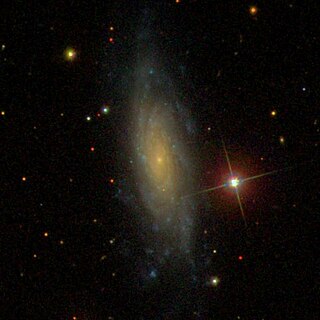
NGC 803 is a spiral galaxy located in the constellation Aries about 70 million light-years from the Milky Way. It was discovered by the German–British astronomer William Herschel in 1784.

NGC 937 is a barred spiral galaxy located in the constellation Andromeda about 251 million light years from the Milky Way. It was discovered by the French astronomer Édouard Stephan on 12 December 1884.

NGC 767 is a barred spiral galaxy located in the constellation Cetus about 241 million light years from the Milky Way. It was discovered by the American astronomer Francis Leavenworth in 1886.
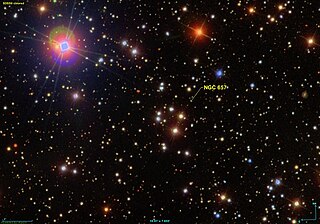
NGC 657 is an open cluster containing very few stars or a group of stars located in the constellation Cassiopeia. It was discovered by British astronomer John Herschel in 1831.

NGC 721 is a barred spiral galaxy located in the constellation Andromeda about 250 million light years from the Milky Way. It was discovered by the Prussian astronomer Heinrich d'Arrest in 1862.

NGC 606 is a barred spiral galaxy located in the Pisces constellation about 470 million light-years from the Milky Way. It was discovered by the French astronomer Édouard Stephan in 1881.




















